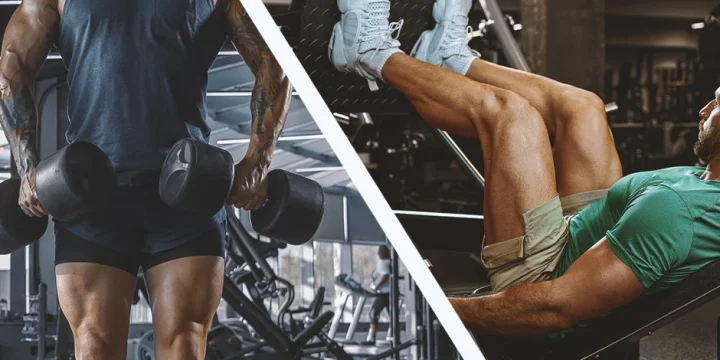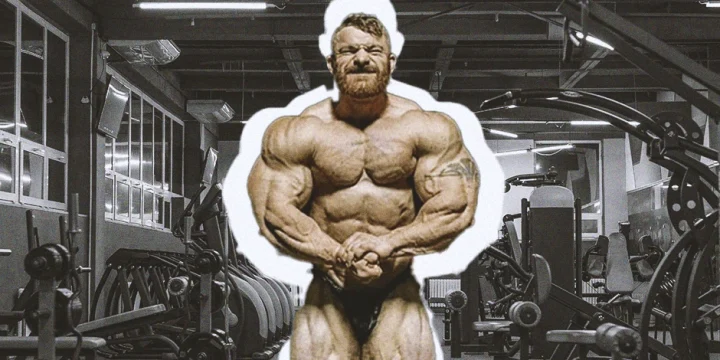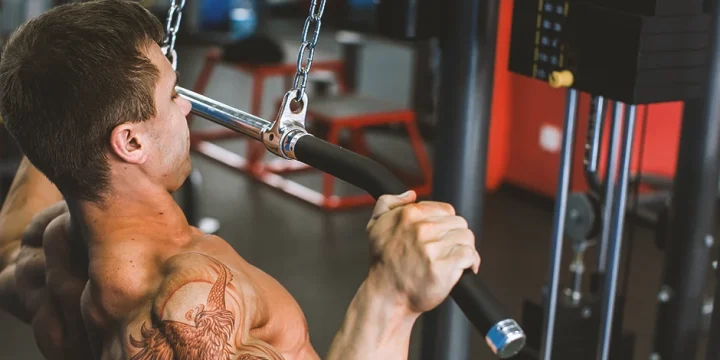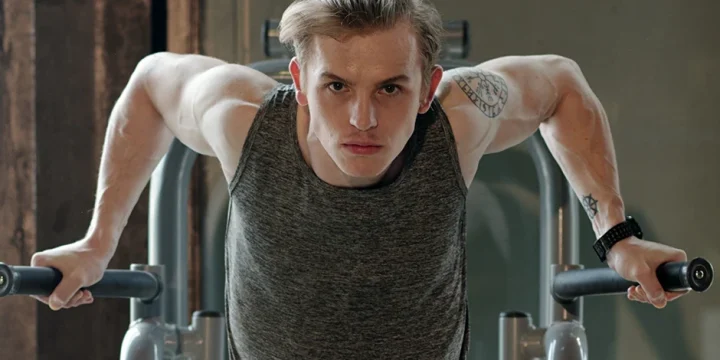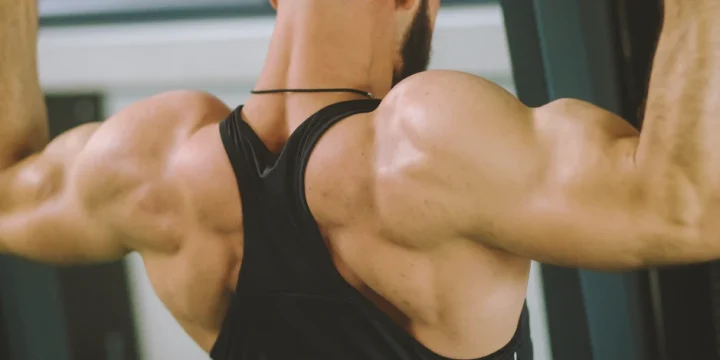The face pull is an undervalued exercise that helps develop your shoulder joint, resulting in stability that transfers to many other activities.
If you don't have the proper training equipment, performing a traditional rope cable face pull isn't easy.
As a certified fitness trainer, I consulted with my colleagues and researched extensively to obtain the best face-pull alternative workouts.
In this article, I will provide my findings and expertise on the anatomy of the muscles worked by face pulls, why the muscles matter and exercises that are the best face pull alternatives.
Keep on reading.
Quick Summary
- To effectively target the rhomboids, rear delts, and mid-traps, and improve shoulder health, incorporate exercises like cable machine external rotation, wide grip inverted rows, and resistance band pull-aparts as face pull alternatives.
- Face pulls and their alternatives are essential for maintaining proper shoulder alignment during exercises such as pull-ups, bench presses, and deadlifts, making these workouts safer and more efficient.
- A National Library of Medicine study showed elastic band exercises notably enhanced pectoralis major length (12.9 to 17.6 cm), decreased forward shoulder angle (32.2° to 29.5°), and augmented craniovertebral angle and upper trapezius thickness.
- In my opinion, incorporating these face pull alternatives into a workout routine can significantly enhance upper body strength and posture, especially for those who engage in heavy lifting or have sedentary lifestyles.
Why Face Pull Is a Good Exercise

A study published in the National Library of Medicine revealed that elastic band exercises significantly improved pectoralis major length (12.9 to 17.6 cm), reduced forward shoulder angle (32.2° to 29.5°), and increased craniovertebral angle and upper trapezius thickness [1].
In my experience as a personal trainer, I've seen face pulls transition from being a staple in powerlifting to gaining significant popularity among my bodybuilding clients.
"They help maintain the shoulders back and squared, preventing the pulled-forward appearance that comes from performing too much front delt and chest training. They also aid in the development of a robust upper back, which serves as a foundation for a strong bench press."
- Robert Herbst, World Champion Powerlifter, and Personal Trainer
Let's look at why face pulls are good workouts.
- Constant tension: You may redirect tension using the cable machine. This can enhance the time a muscle is under constant tension during a rep. Applying substantial stress to the working muscles across the range is feasible during face pull. The muscles function through their whole range of motion, training as many fibers as possible. Greater tension across a complete range implies a stronger training response that equates to improvements in both strength and size.
- They counteract internal rotation: Overemphasis on muscles such as the chest, anterior delts, and lats can induce internal rotation of the shoulders. When these muscles are short and tight, they produce internal rotation, aggravated by long periods of sitting, which is becoming more frequent in modern life. One of the primary advantages of face pull is that they develop the muscles engaged in external rotation, hence reducing common injuries such as impingements.
- Isolation: Isolations enable you to add quantity to muscle groups without severe systemic weariness from which you may not be able to recover or stress supporting muscles that might deal with the added workload. This is what the cable face pull accomplishes. They increase the volume of your upper back and external rotators without increasing the volume of your lats or needing lower back support.
- Maintain shoulder joint stability: Face pull works more than simply the superficial muscles. If done with external rotation, these develop the rotator cuff muscles, supporting the shoulder joint. When seeking to improve your back and the rest of the upper body, shoulder health is essential, providing you with a firm platform to make the most out of your training.
- Prevent scapula winging: Like its capacity to develop external rotators, the face pull strengthens muscles such as the rhomboids to avoid scapula winging. Scapula winging may be produced by repeated motions and can have a severe influence on more than just your exercise if left untreated.
The Best Face Pull Alternatives

There are alternative techniques for training your posterior deltoids, mid-traps, and rhomboids that are as good as a face pull.
Here are our top face pull alternatives.
1. Cable Machine External Rotation
The cable machine external rotation workout is an excellent prehab activity for rotator cuff health.
Rotator cuff injuries are among the most prevalent, especially as lifters age. Prehab workouts like external cable rotations might help you avoid injury and enhance longevity in the gym.
How to perform it:
- Attach a handle to a cable that is slightly above waist height.
- Hinge from the elbow and extend the forearm to 90 degrees, maintaining the upper arm close to the body.
- Outwardly twist the shoulder by pushing the handle across the body away from the chest, preventing your hand from dropping.
- Controllably lower the handles back to the starting position.
- Repeat until the required number of repetitions has been reached.
Related: Best Rotational Exercises
2. Wide Grip Inverted Rows
As a compound exercise, wide grip inverted rows improve upper back strength and muscle mass.
Along with exercising your upper back and rear delts, this workout has tremendous implications on your grip and core strength.
How to perform it:
- Place a barbell horizontally at a height just below your hips.
- Go beneath the barbell and use an overhand grip to hold it. Spread your hands wider than shoulder width.
- Extend your hands and firmly plant your heels on the floor. Your body should be straight, with only your heels touching the floor.
- Squeeze your glutes and tighten your core.
- Lift yourself until the chest almost reaches the barbell. Keep your elbows stretched out to appropriately target your back delts.
- Lower yourself carefully until your hands are completely extended.
- Aim to accomplish 10-12 repetitions in a single set.
3. Resistance Band Pull Apart
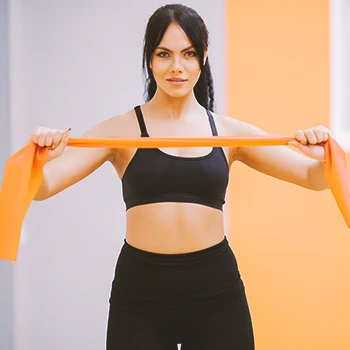
Band pull-aparts are simpler face-pull alternative exercises. This is because its execution requires simply a resistance band. Also, they may be easily performed anywhere.
How to perform it:
- With an overhand grip, grab a resistance band. Maintain your arms shoulder-width apart and stretch your hands until they parallel to your torso.
- Keep your spine neutral, and your shoulder blades retracted.
- Pull the band apart so your arms are entirely stretched at your sides. Squeeze your delts in the back.
- Maintain this posture for 1-2 seconds.
- Return to your starting position slowly.
- Repeat until the desired number of repetitions is attained.
4. Resistance Band Face Pull
Band face pull closely resembles the performance of a traditional face pull. Resistance bands, like cables, guarantee that your back muscles are always under tension.
"Bands produce less resistance compared to a cable pulley, making them an excellent choice for beginners, but they may not give enough challenge after you've developed your strength."
- Andrew Foster, Certified Strength and Conditioning Specialist
How to perform it:
- Attach a resistance band to a stable pole at head height.
- Grab the band using both hands and step back from the pole, so your arms are completely extended and tension in the band is generated.
- With your knees slightly bent, pull the resistance towards your face. Maintain both elbows up and attempt to reach your ears with the palm.
- At this point, squeeze the upper back muscles and hold for 1-2 seconds.
- Slowly extend both arms to return to your starting position.
- Repeat for the desired number of reps.
5. Cable Reverse Flys
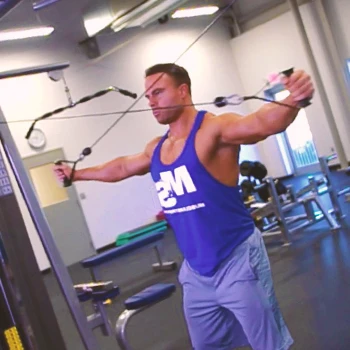
The cable reverse fly is a reverse fly variation intended to develop the rear deltoids.
I've noticed that for many of my clients, the rear deltoids are often a lagging area, yet they play a crucial role in maintaining proper posture throughout the day.
How to perform it:
- Attach a handle to two cables placed at chest height.
- Grab one of the handles across your torso with a neutral grip. Repeat with the other arm.
- Maintain a slight knee bend while holding the handles straight in front.
- Keep a modest bend in the elbows and laterally pull the handles without tightly pushing the shoulder blades together.
- Return the handles to the starting position slowly and carefully.
- Repeat until the required number of repetitions has been reached.
6. Resistance Band Upright Row
The band upright row is a complex exercise that works the trapezius, back delts, and side delts muscles. Since this exercise is done with a resistance band, you can sustain consistent tension on the targeted muscle regions.
How to perform it:
- Take a resistance band and put your feet in the center of it. Grasp the band's ends in each hand.
- Maintain a hip-width distance between your feet.
- Let your shoulder blades retract, and your hands bear the resistance band to hang in front of you.
- Pull the resistance bands towards the chin while pointing your elbows outwards. You must have your elbows higher than your arms.
- At this point, squeeze your back delts and traps.
- Return to your starting position slowly.
- Repeat for reps.
7. Dumbbell Reverse Flys
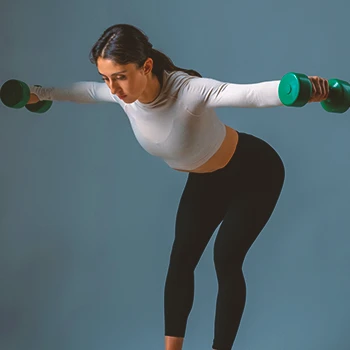
The dumbbell reverse fly is one of the best workouts for developing the back delts.
Its technique is rather straightforward, making it an excellent face-pull alternative exercise.
How to perform it:
- Take a pair of dumbbells and lean your hips forward until your body is roughly parallel to the ground.
- Make sure your feet are shoulder-width apart. Let the dumbbells hang straight from your shoulders, palms facing each other and arms slightly bent.
- Lift your arms to your sides until they align with your body, maintaining your back flat with your torso still.
- Do not change the angle of your elbows.
- Pause for a while, then gently return to your beginning position.
- Repeat for the desired number of repetitions.
8. Wide Grip Seated Cable Rows
While barbell rows are great for the mid-trap, rear delts, and rhomboid muscles, they can be demanding on the lower back.
Sitting cable rows are similarly efficient but considerably easier on the lower back.
This exercise may be performed with a long, straight barbell, although a parallel grip bar may be more comfortable.
How to perform it:
- Sit down and place the handles of a cable pulley unit in front of your abdominal area.
- Connect a parallel gripping bar to the cable and use a neutral grip to hold it. Place yourself away from the pulley till you feel a good stretch in the upper back muscles.
- To steady yourself, place your legs on the footrest. Maintain an upright posture with your shoulders retracted.
- Pull the bar up to your upper abdomen. Your elbows ought to be just below your shoulder height.
- At this point, squeeze the upper back muscles.
- Then, gradually release the weight to return to the beginning position.
- Perform 12-15 repetitions with strict form.
9. Supine Y-Raise
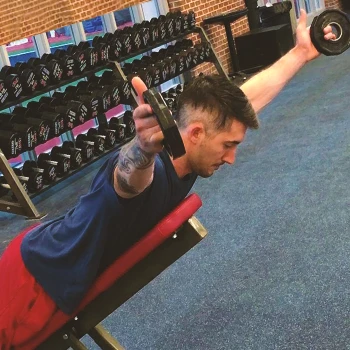
This alternate workout for cable face pulls won't require much weight.
Most individuals will utilize the smallest plates they could find in the gym (about 5lb) since this weight will train the posterior delts, mid-traps, and rhomboids.
How to perform it:
- Place a bench at a 45-degree angle and lie down on it with a load in each hand.
- Let your arms reach down and rotate your hands, so the palms point inward.
- Lift your arms in a V-shape forward without bending the elbows. Point your thumbs upward toward the ceiling.
- Slowly lower your arms and repeat.
10. Lateral Raises
The lateral raise is among the most significant cable face pull-up alternatives, and it provides various advantages to the user, like shoulder strengthening, enhanced mobility, and suppleness.
You will see how difficult the lateral lift is to execute; utilizing lightweight aid the movement's consistency and range.
How to perform it:
- Stand tall with your legs shoulder-width apart, and your knees bent slightly in an athletic pose.
- You need to hold the dumbbells from the sides with an overhead grip.
- Slowly elevate the load up and out to the side while engaging the core.
- To avoid shoulder injuries, carefully drop your arms back to the beginning position in a controlled way after they have reached parallel. Maintain a slight bend in the elbows.
- Repeat for reps.
11. High Cable Pulley Lat Extension
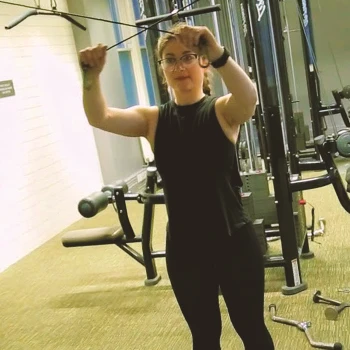
This exercise is excellent for warming your muscles before a big back or shoulder training.
This face pulls alternative works on various muscle groups, including the rhomboids, rear deltoids, traps, and latissimus dorsi.
How to perform it:
- Locate a pulley machine with weights on both sides. Remove all attachments from the pulley machine. This features metal hooks.
- Raise the pulley to its maximum setting after adjusting it.
- Hold the cable ends with both palms facing in, then grip the opposite ends so that your right arm is with the left pulley and your left arm is with the correct pulley.
- Position yourself so that your feet are shoulder-width apart with a square stance.
- Stretch both arms simultaneously in a diagonal manner till they are beside you.
- Maintain the posture for 1-2 seconds when your arms are completely extended and tighten the upper back muscles, then return to the beginning position while the cables are tight.
Face Pulls Main Muscles Worked

Face pulls, unlike seated rows and lat pulldowns, do not train your lats. Face pulls, on the other hand, target the muscle groups that retract the shoulder girdle.
Face pulls mainly work the following muscles:
- Rhomboids: According to the National Institute of Health (NIH), they are found beneath the middle trapezius as well as between scapulae [2]. These, like the mid-traps, draw the shoulder blades back and together. Rhomboid muscles (rhomboid major and rhomboid minor) engage in face pulls.
- Biceps: Face pulls are a complex pulling exercise involving elbow flexion, horizontal shoulder extension, and shoulder girdle retraction. As a result, face pulls train your biceps and the muscles in the upper back and back shoulders.
- Trapezius middle fibers: According to the NIH, the trapezius is a big, diamond-shaped muscle in your upper back [3]. There are three types of fibers, the orientation of which determines their function. In a movement known as depression, the lower traps pull the shoulder girdle downward. The elevation is a movement caused by the upper fibers pulling your shoulder girdle upwards. Retraction is caused by the middle fibers pulling your scapulae and shoulder blades back and together.
- Posterior deltoids: As noted by the NIH, there are three types of deltoid muscles: rare (posterior), anterior (front), and medial (side) [4]. The three deltoids function together to manage your upper arm. The posterior deltoids are particularly active when doing face pulls.
Why These Muscles Matter

In my training sessions, I emphasize to my clients that the posterior deltoids, middle trapezius, and rhomboids are key to the function and stability of the shoulder girdle.
I've observed that exercises like deadlifts, bench presses, and pull-ups become safer and more effective when they focus on keeping their shoulders back and stable.
A firm, sturdy shoulder girdle may lower the risk of shoulder pain and joint injury.
Lastly, hours of sitting bent over a monitor, too much chest exercise, inadequate pec stretching, and the relentless pull of gravity all contribute to rounded shoulders and a hunched upper back in many people.
Face pulls, with their alternatives, are a great solution to bad upper body posture.
Related: Best Hack Squat Alternatives for a Killer Leg Workout
Progression and Regression Strategies
To adapt face pull alternatives for varying fitness levels:
- Beginners can start with band pull-aparts, using lighter resistance bands and focusing on controlled movements to build shoulder stability.
- As proficiency increases, progress to cable face pulls with moderate weight, ensuring proper form and muscle engagement.
- For advanced athletes, intensify the exercise by increasing cable resistance, incorporating unilateral variations, or integrating dynamic movements like a squat-to-face pull.
- Regressions for those needing a gentler approach include seated band face pulls, reducing tension and focusing on slow, deliberate movements.
- Always prioritize form over intensity to maximize benefits and minimize injury risk.
FAQs
Are Face Pulls Worth Doing?
Yes, face pulls are worth doing. They target your rhomboids, traps, and rear delts, which makes your back appear thick, and are also helpful for establishing a sturdy upper body for greater lifts and enhancing your posture.
Which Grip Is Better for Face Pulls?
The optimal grip posture for face pull exercise is underhand; however, ensure that the band or rope attachment moves toward the face, not anywhere else.
What Muscles Does Face Pull Work?
Face pull exercise primarily works the external rotators, back deltoids (shoulders), as well as rhomboids. Maintaining the strength and conditioning of these muscles is critical for bench presses, overhead presses, and push-ups.
References:
- https://www.ncbi.nlm.nih.gov/pmc/articles/PMC4932046/
- https://www.ncbi.nlm.nih.gov/books/NBK534856/
- https://www.ncbi.nlm.nih.gov/books/NBK518994/
- https://www.ncbi.nlm.nih.gov/pmc/articles/PMC3042752/
About The Author
You May Also Like

